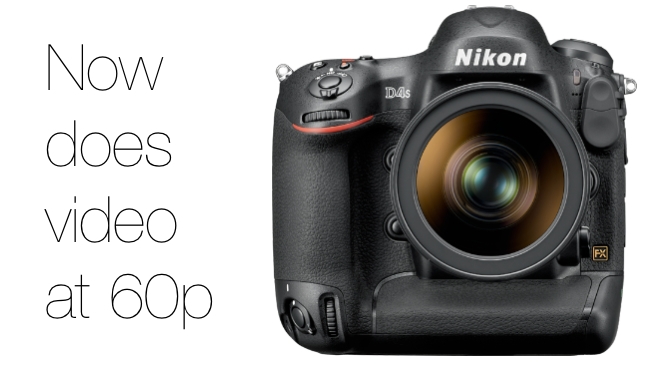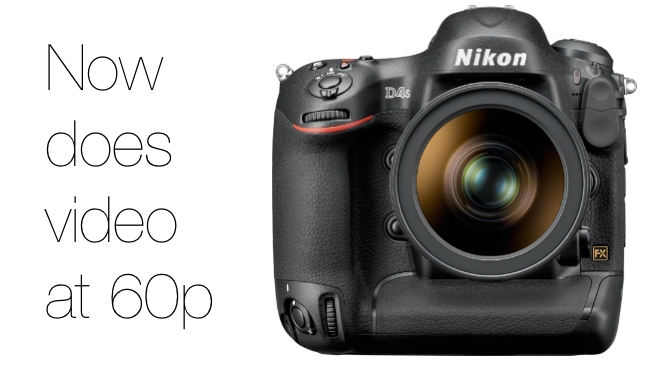
 Nikon D4s
Nikon D4s
In addition to a new low light sensitivity, Nikon’s D4 (now with an additional “s” now shoots progressive video at 60 frames per second
The Nikon D4 has evolved into the D4s, and is modestly described by its manufacturer as “the ultimate imaging machine”.
Although on the face of it the upgrade is relatively incremental, all of the changes bring significant extra capability to this large, professional camera, for still and video shooters alike.
Interestingly, the sensor remains at 16 megapixels, a figure that is now supported by mainstream smartphones, which demonstrates, surely, that there is more to quality than the absolute number of pixels (Canon’s 1Dx and 1Dc cameras have an 18 megapixels).
Better low light performance
Low light performance has been boosted to an eye-watering ISO 409,600 in extended mode. A new EXPEED 4 processor helps to reduce noise while maintaining sharpness.
Video recording is now possible at 50p/60p and a clean HDMI output is available for use with external recorders.
Here’s Nikon’s press release in full:
London, UK, 25th February 2014 Nikon today announces the D4S, a new 16.2 megapixel FX-format flagship camera built to keep professionals ahead of the game.
The ultimate imaging machine has advanced: as the successor to Nikon’s acclaimed D4, everything about the D4S powers exceptional images at exceptional speed. An expanded ISO range and EXPEED 4 image processing take low light photography to another level, making the D4S a master of the dark as well as the light. Advances to AF performance offer improved acquisition and tracking at 11 fps, plus much finer control over the AF area with the new Group Area AF mode. Nikon’s RAW Size S file format accelerates image transfer onto networks and a Gigabit 100/1000TX Ethernet port enables ultra-fast connection.
Hiro Sebata, Professional Product Manager at Nikon UK, comments: The Nikon D4S follows the success of the D4 and brings with it a new level of performance designed to meet the needs of the most demanding photographers.”
He adds: “Nikon engineers have taken on board valuable feedback from professional users in order to implement a wealth of improvements that will make all the difference to professionals working in the intensely competitive fields of sports, press, and nature photography. Equipped to power ahead in the most challenging environments, the D4S ensures serious photographers stay ahead of the game.”
Built upon success
Moving beyond the limits its predecessor was built to push, the D4S blazes a new trail for high-speed professional image making. The camera’s revamped sensor offers the ultimate image quality, and the expanded ISO range of 100–25600 is extendable up to an industry-leading 409600 (equivalent). Nikon’s new EXPEED 4 image processing engine boosts the camera’s overall performance to a whole new level, vastly improving image rendering and ISO performance. A true master of the dark as well as of the light, sophisticated localised noise reduction, edge sharpening and tone control ensure the D4S delivers outstanding results in the kind of ‘dirty’ low light conditions many sports and news photographers are confronted with. The burst rate of 11 fps is not compromised by ISO settings or lens choice, and details are rendered sharp and exceptionally well defined even when Noise Reduction filtering is applied. As with the D4, the D4S is built to sustain peak performance in the most demanding environmental conditions imaginable. The camera is protected by a tough weather-sealed full metal body and features subtle details that make all the difference to handling: changes to button layout and re-shaped control buttons improve operation in damp conditions whilst the re-contoured design and smoother grip make it easier to hold out in the field...
Full throttle: stop at nothing
Everything about the D4S is built around the need for speed. In a world where the speed of transmission and networking has become as important as megapixels and ISO settings, the D4S delivers on every count. The frame-per-second with autofocus tracking has increased from 10 fps to 11 fps, making the D4S the fastest autofocus D-SLR-camera in Nikon’s history. The camera implements a Gigabit 100/1000TX Ethernet port and offers a new RAW Size S option for accelerated image transfer. When milliseconds matter, the shutter’s 42 ms lag can gain you the critical edge, taking pictures in less than the blink of an eye; and a completely new shutter and mirror mechanism reduces mirror bounce, delivering a stable viewfinder image with minimal viewfinder blackout when shooting at high speed.
Bettering the best: AF advances
The D4S takes the class-leading accuracy and usability of Nikon’s renowned 51-point AF system and advances it further. In addition to improved lock-on, expanded ‘Store by orientation’, and new options for AF mode restrictions, the D4S boasts a brand new Group Area AF mode. Designed to allow much finer control over the size of the autofocus area, Group Area AF constantly monitors five different AF fields, which can be shifted across the 51-point array as composition demands. Shooting in this mode enables fast moving subjects to be tracked with phenomenal precision over long distances, and greatly improves acquisition and background isolation when shooting subjects that are comparatively small and close to a high-contrast or distracting background. As with the D4, the AF system inside the D4S is configurable in 9-point, 21-point and 51-point coverage settings and sensitive down to -2 EV (ISO 100, 20°C/68°F).
Multi-area D-Movie evolves
For moviemaking in diverse conditions, the D4S offers broadcast-quality video in multiple frame formats and boasts a range of operational enhancements that allow more control over footage while filming and improve sound recording. D-movies are now possible at 50p/60p, and photographers can set sensitivity and select maximum ISO in M mode, plus select the sensor crop format, control power aperture, and fix shutter speed. In addition, Nikon’s 3D noise reduction reduces random noise and noise flicker when filming at high sensitivities. As with the D4, the D4S offers three sensor crop formats, FX, DX, and native crop (approximately 2.7x) and uncompressed full-resolution HDMI output to external devices. You can simultaneously record full resolution HD movies in-camera and with an external recorder via HDMI (an HDMI cable clip is provided with the camera for a secure connection). Sound recording has improved thanks to more options for audio control, including the option to select the sound range (wide/voice), and reduce wind noise when recording with the built-in microphone.
Summary of key features:
Revamped 16.2-MP FX-format sensor: offers the ultimate in image quality and excellent cropping flexibility.
Phenomenal light sensitivity: ISO range of 100–25600 is extendable up to an industry-leading 409600 (equivalent).
11 FPS with AF: 11 fps in FX format with AE/AF superior to the D4.
EXPEED 4: boosts the camera’s overall performance to a whole new level.
Multi-CAM3500FX 51-point AF system configurable in 9-point, 21-point and 51-point coverage settings and sensitive down to -2 EV (ISO 100, 20°C/68°F).
AF advances: improved lock-on, new options for AF mode restrictions, plus the new Group Area AF mode.
Multi-area D-Movie: Full HD (1080p) movies in FX- and DX-format at 60p/50p/30p/ 25p/24p frame rates. Offers three sensor crop formats FX, DX and native crop (approximately 2.7x) and clean HDMI-out. Access the ISO range from ISO 200 up and control shutter speed, aperture and audio levels while filming. Nikon’s 3D noise reduction reduces random noise, and the camera offers sophisticated options for audio control.
Tough in the field: weather-sealed full metal body.
Fast track: Gigabit 100/1000TX Ethernet port and RAW Size S file format for accelerated image transfer. Compatible with Nikon’s WT-5 Wireless Transmitter.
Colour adjustable monitor: anti-reflective 8 cm (3.2-in.), 921k-dot LCD monitor that lets you push the colour balance and brightness in any direction.
Fast durable shutter: Kevlar/carbon fibre-composite shutter unit with 42 ms shutter lag, standard life cycle rating of 400,000 releases and a shutter speed of 1/8000 to 30s, with flash synchronization at up to 1/250 sec. A new shutter and mirror mechanism delivers a stable viewfinder image with minimal blackout during high-speed shooting.
Spot White Balance metering: easily acquire manual, pre-set White Balance data based on the selected area within the frame: the size of the area acquired can be retained even when the image is enlarged, and consecutive data acquisition is possible.
High-capacity EL-18a battery: ultra-compact and lightweight lithium-Ion rechargeable battery with a capacity of 2500 mAh (10.8V).
Storage media: two card slots—one for high-speed CF (UDMA 7) cards, and one for high-speed, high-capacity XQD cards.
Tags: Technology


Comments